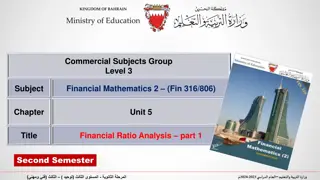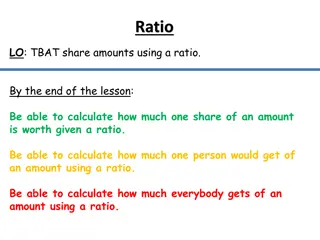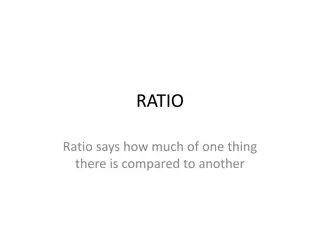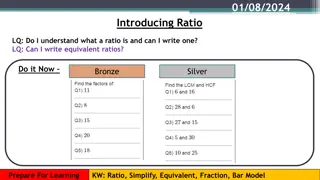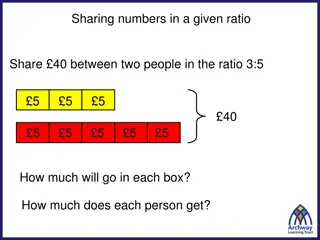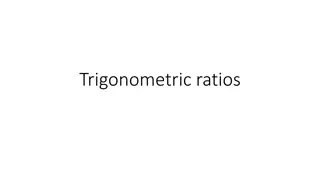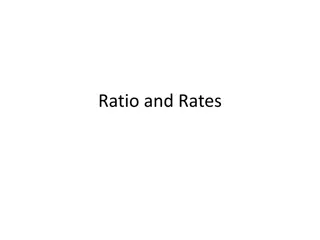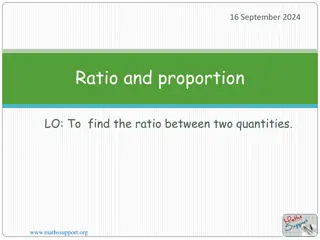Financial Ratios for Entrepreneurial Success
Financial ratios are essential tools for entrepreneurs to assess business performance and make informed decisions. Learn how to interpret profitability ratios like gross profit margin and net profit margin to enhance your financial management practices.
Download Presentation

Please find below an Image/Link to download the presentation.
The content on the website is provided AS IS for your information and personal use only. It may not be sold, licensed, or shared on other websites without obtaining consent from the author.If you encounter any issues during the download, it is possible that the publisher has removed the file from their server.
You are allowed to download the files provided on this website for personal or commercial use, subject to the condition that they are used lawfully. All files are the property of their respective owners.
The content on the website is provided AS IS for your information and personal use only. It may not be sold, licensed, or shared on other websites without obtaining consent from the author.
E N D
Presentation Transcript
Entrepreneur Entrepreneur Local Learning Centers Local Learning Centers
SEMINAR 30: HOW TO READ FINANCIAL RATIOS Financial ratios offer entrepreneurs a way to evaluate their business performance. They are created using numerical values taken from financial statements to gain meaningful information about a company.
Financial Ratios: Starting Info Financial ratios are commonly used by lenders such as a bank or organizations like KRG to determine the stability and health of your business just by looking at your balance sheet. They can also make stable financial ratios a part of your business loan agreement. Ratios should not be evaluated only when visiting your banker. Ideally, you should review your ratios every month as you do your bookkeeping and budgeting. This will keep you on top of changing trends in your financial performance to help you make the best decisions.
The Advantage of Using Ratios Here are the two basic categories for start-ups. The profitability ratios: provides indicators such as gross margin and net profit margin. The liquidity ratio: is an indicator of your ability to turn assets into cash quickly. What are the advantages of ratio analysis? It simplifies the financial statements. It highlights valuable information in a simple form rather than performing an analysis of a financial statement.
Profitability Ratios How well does your business generate profits? Here are the two profitability ratios that you need to know: 1. Gross profit margin 2. Net profit margin
Gross Profit Margin Gross profit margin: The gross profit margin tells you what your business made after paying for the direct cost, including labor, materials, and other direct production costs. Without a high enough gross profit margin, you won t have a viable business, at least not for long. Formula and Calculation for Gross Profit Margin: *Remember: Multiplying the figure by 100 will convert it to a percentage. Gross profit margin = Gross Profit / revenue x 100*
Net Profit Margin Net profit margin: The net profit margin illustrates how much each revenue dollar translates into profit. This ratio is considered one of the most important indicators of a company's overall financial health. You can assess whether current practices are working and forecast profits based on revenues by tracking increases and decreases in your net profit margin. In practice, since the net profit margin is expressed as a percentage rather than a dollar, it becomes easy to compare the profitability of two or more businesses regardless of size. Formula and Calculation for Net Profit Margin: Net profit margin = Net Profit / revenue x 100 The following slides will contain tables to demonstrate these concepts in action. We suggest you follow the excel tables to fully understand the info!
INCOME STATEMENT, KUUJJUAQ COLORFUL SCARVES, YEAR ENDED DECEMBER 31, 2022 Income Sales revenue Cost of goods sold Gross Profit Total Operating Expenses: Earnings Before Interest, Taxes, Depreciation, and Amortization (EBITDA) (Gross profit - Operating Expenses) Pre-Tax Profit and Other Income (EBITDA- debt - depreciation) Pre-Tax Profit Taxes (18 % of pre-tax) Net Profit $ 55 930,00 $ 18 317,50 $ 37 612,50 $ 28 736,50 $ 8 876,00 $ 7 954,00 $ 1 431,72 $ 6 522,28 RATIOS: Gross Profit Margin (Gross profit / Sales revenue X 100) 67% Net Profit Margin (Net profit / Sales revenue X 100) 12%
Lets put this table into words: For instance, a 67 % gross margin means that for every $100 in revenue, the company pays $33 in costs directly connected to producing the product or service, leaving $67 as gross profit. In relation to the Net Profit Margin, the business managed to generate profits worth 12 cents for every dollar worth of sales. A good net profit ratio can vary depending on the industry: For example, a good net profit ratio might be between 0.5% and 3.5% in the retail and restaurant industry. Businesses should aim for profit ratios between 10% and 20% while paying attention to their industry's average.
Liquidity Ratios Does your business have enough cash to pay the bill? Even if your business is currently profitable, bankruptcy is a constant danger. All it needs is a few missed payments due to accounts receivables and payables not lining up well. To keep track of your capacity to pay your debt, you can use the two following indicators. The financial information needed to estimate this ratio is found in the balance sheet. The following slides will offer in-depth explantations of these two indicators, called Quick Ratio and Current Ratio.
1. Quick ratio: (also called cash ratio or acid test ratio) indicates if your company can immediately pay its debts using its most liquid assets (cash or assets that are easily converted into money), also called quick assets. Your quick assets are cash, money in the bank, account receivable, and pre-paid account short-term investments that are easy to convert (marketable). Your current liabilities are any short-term debt such as credit card debt, accounts payable, bank operating credit, accrued expenses, and taxes payable. To estimate your quick ratio, you need to divide your current liabilities by your quick assets: Quick ratio = Current liabilities / Quick assets A quick ratio of less than 1 is a low score and means that your company has no liquid assets to pay its current liabilities and should be treated cautiously. A low ratio means that you might have difficulty meeting your obligations and may not be able to take advantage of opportunities that require quick cash. A quick ratio of 1 and + indicates that your company could pay off its current liabilities without selling any long-term assets. For example, a quick asset of 2 shows that the company has twice as many quick assets as current liabilities. Continued
1. Current ratio: measures your businesss ability to meet its short-term liabilities (within the year) when they come due. Current assets are quick assets + inventory. To estimate your current ratio, you need to divide your current liabilities by your current assets: Current ratio = Current liabilities / Current assets A ratio value lower than 1 may indicate a liquidity problem and the need to secure other forms of financing. Recommendations: Paying off your debts can improve this ratio; Delay purchases or consider long-term borrowing to repay short-term debt. Review your credit sales policies with clients and possibly adjust them to collect outstanding payments quickly. Let s go back to the Kuujjuaq Colorful Scarves balance sheet to evaluate these two liquidity ratios.
These next two slides represent a balance sheet from Kuujjuaq Colourful Scarves the first represents Assets, with the next slide showing Liabilities. You are encouraged to switch between them to compare and contrast figures. Assets Cash/ bank account Accounts receivable Inventory Pre-paid expenses Current assets Long-term Assets: Equipment (see depreciation tab) $9 008 $3 995 $13 003 $2 590 Total long-term Assets: Total Assets $2 590 $15 593 Quick Cash Current assets (Quick cash+ inventory) $9 008 $13 003
Liabilities Quick assets ratio (Quick cash/Current liabilities): Current Asset Ratio (Current assets/Current Liabilities): Line of credit Due accounts Taxes to pay (receivable) Income taxes to pay (receivable) CT portion of the LT debt Short Term Passive Assets Total Long Term Passive Assets LT borrowed Other LT passive assets Long Term Passive Assets Total Total Liabilities Long Term Passive Assets Total Total Liabilities Shareholders' equity Owner/ shareholders' equity Retained earnings (net profit reinvested) 1,45 $570 $1 432 $4 197 $6 199 2,10 A ratio of 2.10 means current assets are twice as large as current liabilities. A current ratio of less than one indicates the company might have problems meeting short-term financial obligations. $373 $373 $6 572 In some cases, the liquidity ratio is over 6, which indicates that some of your money is not being put to work. This money could be used to settle some debts. In the case of a start-up, a high liquidity ratio can also protect your business from the newcomers challenges. $2 500 $6 522 Total Shareholders' equity Total liabilities and shareholders' equity Current liabilities $9 022 $15 595 $6 199
SELF-EVALUATION For this exercise, you are asked to calculate the Gross Profit Margin (GPM) and Net Profit Margin (NPM). Income Sales revenue Cost of goods sold Gross Profit Net Profit $ 125 987,00 $ 36 952,00 $ 89 035,00 $ 12 056,00 Select the correct answer to continue. GPM: 81% NPM: 24% GPM: 68% NPM: 71% GPM: 71% NPM: 10% GPM: 57% NPM: 10% GPM: 81% GPM: 68% GPM: 71% GPM: 57% NPM: 24% NPM: 71% NPM: 10% NPM: 10%
Congratulations, you are correct! Click here to continue. Click here to continue.
Sorry. Please try again. Click here to try again. Click here to try again.
TRUE OR FALSE The financial information needed to estimate liquidity ratios is found in the balance sheet. True False True False
Congratulations, you are correct! Click here to continue. Click here to continue.
Sorry. Please try again. Click here to try again. Click here to try again.
GLOSSARY - Current Assets: Current assets include cash, short-term investments, prepaid expenses, accounts receivables, and inventories. - Current Liabilities: Current liabilities include credit card debt, accounts payable, bank operating credit, the portion of long-term debt expected to be repaid within one year, accrued expenses, and taxes payable.





